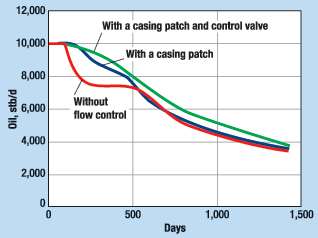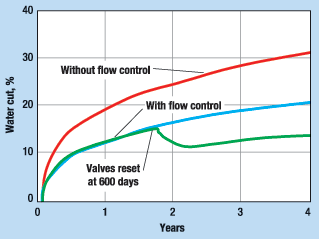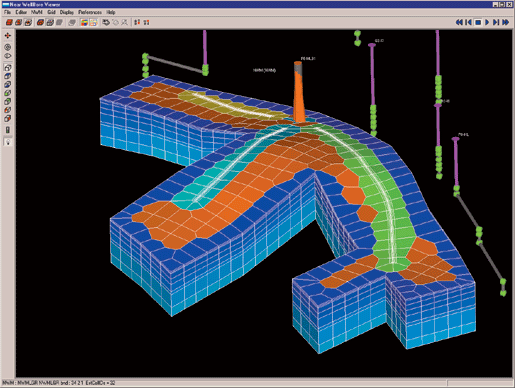Setting the value of permanent monitoring and control
INTELLIGENT WELL COMPLETIONSSetting the value of permanent reservoir monitoring and controlCase histories show the tangible benefit of reservoir and well software model monitoring and resulting control of the downhole completions via intelligent-well methodsJeb Tyrie, Schlumberger, Aberdeen, Scotland Reservoir performance monitoring and control is a complex discipline with a single purpose: to provide an operator advanced understanding of a reservoir’s dynamics and the capability to manipulate downhole flow to optimize production while minimizing intervention costs. To do so requires building and using appropriate geological and engineering models as well as advanced, permanent downhole monitoring and control technologies. Today’s capabilities find the industry very close to being able to routinely create and manage "live reservoirs," even in quite-remote locations. This article focuses on intelligent completions, specifically downhole flow-control valves, which make permanent well monitoring and control possible, as well as the software tools that support them. These hardware and software technologies combined are key to proactive reservoir management. A Lifetime Of Data It can be difficult to predict the exact nature of a reservoir’s lifetime performance. Not only do inherent structural / stratigraphic heterogeneities cause reservoir discontinuities, but also, the act of producing creates pressure differentials unique to a given reservoir. Further, when water or gas breaks through early, the relative permeability of a single zone within a multizone reservoir may be altered, distorting a complex situation. Simply put, reservoirs seldom perform in strictly predictable ways. They are multifaceted, and dynamic when produced. To effectively manage a reservoir thus requires the monitoring of as many parameters as possible throughout its life (spud-to-plug). Reviewing mature fields to identify targets for increased recovery requires highly detailed analysis that is more rigorous than required at earlier field-life stages. Good well-monitoring data is critical to this stage, yet it is often hard to economically justify all the monitoring and, sometimes, at the time a particular piece of data is collected, it is difficult to see its value. However, when analyzing a mature field, it is frustrating to not have detailed data available, or to find that data was gathered, but lost because its value was not understood. Field management requires models, including: analytical and numerical reservoir simulations based on sound geoscience and backed up by nodal-type wellbore and network simulations, as well as facilities simulations to ensure that all the chokes (pore-to-pipeline) are included. Given the appropriate data, these models can then be used to evaluate reservoir performance and plan effective interventions. With the advancement of intelligent, multilateral completions, and robust data management and delivery systems, reservoir performance specialists can receive, right on their desktop computer, all the data required to feed these models and design flexible intervention options. The Monitor, Assess, Control Loop Intelligent completion systems couple three distinct elements: 1) permanent downhole monitors; 2) reservoir engineering experts armed with digital data communication, management and processing / analysis tools; and 3) downhole flow controls. Permanent downhole monitors can vary from simple pressure / temperature sensors to more sophisticated fiber optics for distributed pressure / temperature sensors and three-phase flow / density measurements. Using the latter type it is possible today to monitor, in real time, performance of specific zones in a well. Reservoir engineering expertise and advanced simulation software come together to enable real-time updates to production and reservoir models. Downhole flow controls are used to choke flow from different zones and optimize current production and long-term reservoir recovery.
With all three of these elements in place and communicating in real time, the loop is potentially closed such that the reservoir can "tell" the models what is happening and the models can optimize the flow control valves to improve production. There is quite a bit of territory to cover before such a system is fully functioning; however, the components to do so exist today. The introduction of flow control valves has been a major step forward in this vision. Downhole Flow Control Downhole flow control valves are now field-proven and sufficiently reliable to add significantly to well value, Fig. 1. Infinitely variable downhole valves give the same, or greater, level of inflow control as a surface choke used to commingle production. The remote element in these systems is very similar to a subsea choke set-up, where remote monitoring and control is used to commingle flow from two subsea wells. To date, downhole flow control has been applied in a variety of configurations, many of which are applicable to most fields. These include: flow control from multilateral branches, flow control from separate zones in a single well (vertical, deviated, horizontal and injectors), and inflow control of gas cap gas for lift purposes. In most applications, the devices are used to control water or gas inflow and thereby improve sweep efficiency and maximize production. Downhole flow control valves have been run in cemented and perforated liner sections, on gravel pack completions, and with various levels of multilateral junctions. They have been successfully used on land, platform and subsea wells. Technology take-up has been slower than expected because of factors including: poor understanding of the technology, the multidisciplinary nature of intelligent completions, and problems quantifying the value such a completion will bring vs. additional cost incurred. A full range of downhole flow control valves is available, including hydraulically and electrically operated versions, and tubing or wireline retrievable variations. Extensive field experience with these technologies on projects in the UK, West Africa, the Middle East and Norway has proven them reliable under all types of well conditions. And, a wide range of advanced software tools to simulate advanced well completion designs is available. Simulating Completion Designs To simulate and gain a reliable estimate of the results achievable with a given well completion design, software tools are typically employed. For example, multisegment well modeling, within the Eclipse MSW module from Schlumberger, allows accurate flow modeling of three-phase and compositional fluids in wellbores, annuli and multilateral branches, as well as through valves. This tool also provides the facility for data matching from permanent or wireline sensors, well tests and production perturbations. It also helps with optimizing the settings of intelligent completions to achieve the correct flow from each part of the reservoir. To accurately model production inflow to a well, the area around the wellbore must be modeled in detail. Thus, near-wellbore modeling, within the Eclipse NWM module, uses unstructured grids to fit reservoir grids to the wellbore and capture the direction of fluid flow. This can be done with "slinky" horizontal, multi-branched, or relatively simple wells, and removes the problem of grid-orientation effects, which distort the flow and numerical calculation in the simulator. It is the reservoir that has the production problems; the wells only exacerbate or ameliorate them. Multisegment well modeling and near-wellbore modeling together provide an accurate picture of production dynamics, freeing the completions and reservoir specialists to design the optimum completion solution – one that will do the best job possible with a given reservoir. Case Studies Establishing the value of downhole flow-control completions is actually quite simple. All that is required is to run a simulation model on a well completed both with and without advanced completion equipment. The pressure and production results derived very often argue a good case for this technique. Controlling water production. For an example simulation model application, take the case of a horizontal injector-producer pair in a good-quality formation with an open channel running directly between the two wells. The channel width is 10% of the length of the horizontal well and has ten times the permeability of the surrounding rock. From a production standpoint, this situation is difficult to control, as water will always find its way into the channel. Typically, a casing patch would be run to shut off the channel and reduce water production. Today, however, use of advanced completions provides other options for improving flow control. Three possible completion options were investigated using multisegment well modeling before choosing a particular course of action. Case 1 modeled flow along the existing open wellbore, including the open channel using 25 well segments. Case 2 modeled flow with the channel and neighboring perforations blocked off with a casing patch, again with 25 segments. Case 3, requiring 42 segments, Fig. 2, modeled flow using both a patch and an intelligent completion capable of monitoring and controlling flow via two downhole valves placed at the well’s toe and heel. An annular isolation packer created two annular sections. The key objective of downhole flow control is to create more even flow through the reservoir. In the Case 3 solution, the valves divert fluid away from the channel to improve sweep and production rates.
The production graphs tell the story further, Fig. 3. The Case 1 solution (red) cuts water very early and loses production, while Case 2 (blue) shows that the casing patch is quite successful at stopping early water. However, only the patch plus flow control scenario (green) both optimizes production and controls water in later time. In this simple case, the intelligent completion would add about 900,000 stb of oil, or 10%, to reserves over four years. This is in addition to accelerating oil and reducing water production, thus eliminating associated environmental and logistical problems.
Controlled commingled flow. In another example, from the North Sea, a small, subsea-satellite well was modeled to maximize production and recovery through controlled commingled flow. The aquifer was of unknown size and strength and there were risks that the well could water out either from strong edge drive to the top A sand or by coning to the B sand lying below a strong shale barrier. For this subsea development, two tubing-retrievable, hydraulic, flow-control valves were proposed. Also included was an advanced meter positioned to monitor pressure, flowrate and watercut of the B sand contribution. The wellbore was modeled, assuming both no flow control and then the two control valves described, using the multisegment well technique within the Eclipse reservoir modeling system. Results showed that the flow control valves would have an even more dramatic impact that those used in the previous case. Case 1 (Fig. 4, red) assumed no flow control and water cut reached 20% in less than a year and over 30% in four years. In Case 2 (Fig. 4, blue), flow control reduced watercut to 13% and 20%, respectively, during the same periods. The hydraulic valves specified had up to 11 preset choke settings that could be changed regularly, so based on the flowmeter readings, the well could be continually optimized to reduce watercut. In Case 3 (Fig. 4, green), the valves were reset at 600 days to further optimize production. Cases 2 and 3 would recover an additional 1.0 MMstb of oil over four years. This adjustment reaped further environmental and production benefits as well.
Near-wellbore modeling. When simulating the impact of flow-control valves, there are cases requiring a finely tuned description of the wellbore location within a multidimensional model. This is done using the near-wellbore modeling technique. The user simply selects a volume of interest from an existing reservoir model. This volume then undergoes advanced local grid refinement; the reservoir grid is fit around the wellbore, allowing the professional freedom to design the optimum well. Next, the user loads the deviation survey and designs the perforations along the wellbore. The near-wellbore modeling software then creates an unstructured grid. This can be run as a stand-alone sector model, using boundary conditions defined within the primary model, or as a local grid refinement within the full-field reservoir model, Fig. 5.
In another example, the near-wellbore technique was used to model the impact of different horizontal wellbore dips, lengths and orientations for a major North Sea operator. The study was part of a flow-assurance exercise in which the impact of mud-filtrate invasion in a tight gas-condensate well was examined. This involved modeling 12 to 36 in. around the wellbore. Near-wellbore modeling enabled the practical examination of multiple scenarios, which is impractical with other techniques, and eventually led the operator to reduce the length of its well, saving valuable time and expense while optimizing returns. Managing The Living Reservoir Advanced completion tools already on the market, permanent reservoir monitoring and control systems among them, enable the optimization of highly complex reservoir systems at any time during well life. The very same modeling techniques used to select an appropriate completion system can be used to demonstrate a completion component’s technical and economic value prior to field implementation. Subsequent field results have demonstrated the accuracy of the modeled performance results. Through today’s fast, reliable, secure communications networks and current data-management capabilities, the historical and real-time field data required to apply the models described herein can be ported right to the professional’s desktop computer. The power of today’s modeling and simulation techniques can thereby be used to examine and minimize any deviations from expected production profiles as they occur. Improved well designs and practical, real-time reservoir control put our industry very close to managing the "living" reservoir. Note: This article contains material introduced by the author in his presentation, "Establishing the value of reservoir monitoring and control," presented at SMi’s Smart Reservoirs III Conference, London, July 2 – 3, 2001. Acknowledgment The author would like to acknowledge the input from Sam Gomersall (Marketing Manager, Schlumberger Reservoir Completions) and the support from his colleagues, Andrew Louden, Jim Laidlaw and Steve Wilson.
|
||||||||||||||||||||||
- Coiled tubing drilling’s role in the energy transition (March 2024)
- Using data to create new completion efficiencies (February 2024)
- Digital tool kit enhances real-time decision-making to improve drilling efficiency and performance (February 2024)
- E&P outside the U.S. maintains a disciplined pace (February 2024)
- U.S. operators reduce activity as crude prices plunge (February 2024)
- Drilling advances (January 2024)
- Applying ultra-deep LWD resistivity technology successfully in a SAGD operation (May 2019)
- Adoption of wireless intelligent completions advances (May 2019)
- Majors double down as takeaway crunch eases (April 2019)
- What’s new in well logging and formation evaluation (April 2019)
- Qualification of a 20,000-psi subsea BOP: A collaborative approach (February 2019)
- ConocoPhillips’ Greg Leveille sees rapid trajectory of technical advancement continuing (February 2019)








